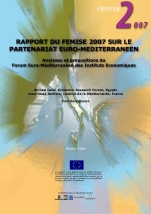Femise Report on the Euro-Mediterranean Partnership 2007
(February 2008)

Rapport Annuel 2007
Introductory Chapter:
a glance at the economic and social performance of the Mediterranean Partner Countries
Some Stylized facts
A trade liberalization of goods that has clearly been beneficial
A beginning of convergence with the EU in terms of per capita income
Progress to be made to meet employment needs
A pattern of growth that requires an increase in investment rates and productivity to ensure its sustainability
A macroeconomic equilibrium that is currently maintained but threatened by inflationary pressure
An international trade position of the MPs market with deterioration in manufactured goods trade, a slight disengagement vis-à-vis the EU and a limited development of the intra-branch trade
Ongoing reforms in all domains but a hierarchy needs to be specified
Chapter I- The Challenge Of Employment In The Southern Mediterranean Countries
I. Introduction
II. The Nature Of The Employment Challenge And Demographic Trends
II.1 Stylized facts : 3 factors of tension on the labor markets
II.2 Necessary job creation in the region in the coming 15 years
II.3 Are the actual trends compatible with the needs?
II.4 Can migration offer a solution that could ease a «euromed labour market»?
III. The Root Causes Of The Problem
III.1 The growth-employment relationship in the MPs
III.2 Adequacy of domestic and foreign investment
III.3 The mismatch between education outcomes and labour market demand
III.4 Widespread informality
IV. Competitivness, Openess And Labor Market Policies
IV.1 The compatibility of the pattern of specialization and employment with openness in the MPs
IV.2 Labour cost and salaries
IV.3 Do Institutions and policies of the MPs optimize the benefits openness, both on the macro and employment levels?
V. Meeting The Employment Challenge: Key Issues Identified
V.1 The need for an overall strategy
V.2 Encouraging the women to take part in the labour market
V.3 Reducing the size of the informal sector
V.4 Improving the employment of a better educated population
V.5 Coordinating cooperative migration schemes
Chapter II-Liberalisation of services
I. Framework for Services Liberalization
I.1. Network Industries
I.2. Liberalization Of Banking Services
I.3. Maritime Freight Transportation
I.4. Liberalization Of Other Services In The Eu
II. The Role of Services as the Factor of Integration of Euromed
II.1. The importance of services and network sectors in five MENA countries
II.2. Services liberalization in the MENA countries
III. Implications of Liberalization of Trade in Services and Network Industries
III.1. Quantifying Barriers To Trade In Services And Network Industries
III.2. Implications Of Liberalization
Annexes
Annex 1. Macroeconomic evolution of the 10 MPs
Annex 2. Multicriteria analysis methodology
Annex 3. Soucres of growth in the 10 MPs
Annex 4. Total Population and the evolution of the Working Population
Annex 5: Net migration flows in the EU-27 (per 1,000)
Annex 6: Migrations stock and flows in MPs
Annex 7: Remittances & FDI as % of GDP in MPs
Annex 8: The equilibrium mechanism of the current account for the 10 MPs
Annex 9 : Unit Value of Export, productivity and wages per capita
Annex 10a: Trade-policy reform progress, 2000-06
Annex 10b: Tariff and nontariff protection in the region, 2000 (or closest year available)
Annex 11: Labour Policies oriented to encourage Women participation


